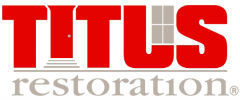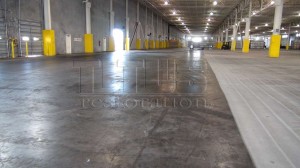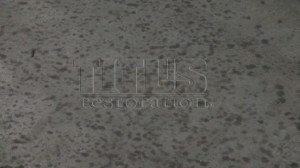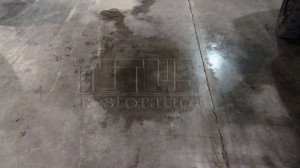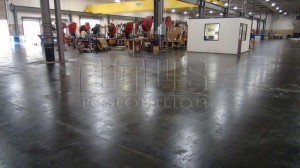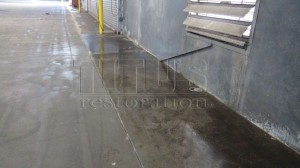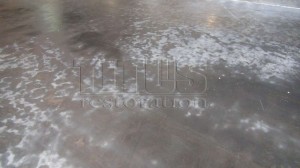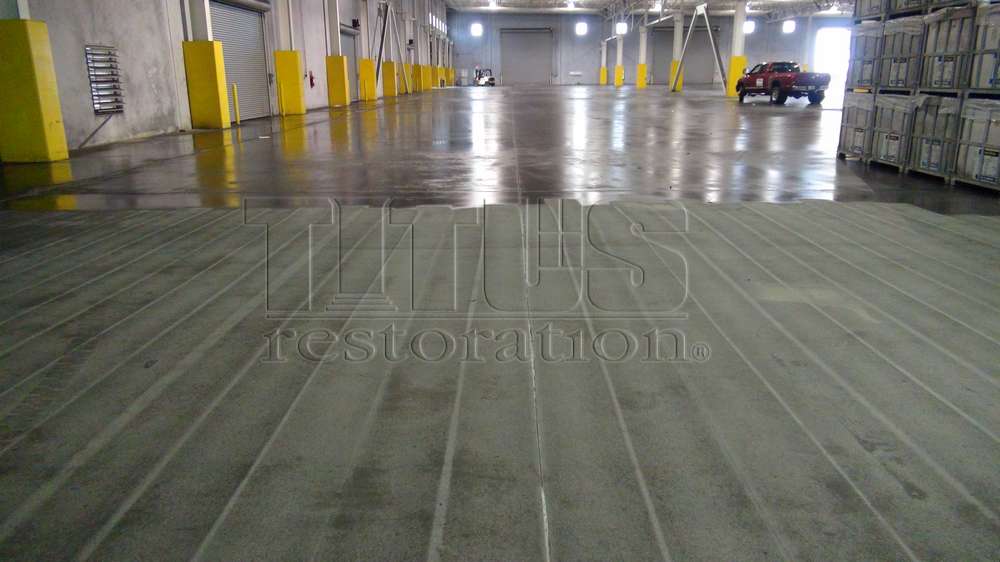If you have wet concrete floors it can be very dangerous. This condition is an especially dangerous concrete floor if it is inside a factory or a warehouse that has steel troweled concrete. Safety becomes an even greater issue when there is both human and forklift traffic in the same area.
The picture above shows a large ocean side warehouse at a shipping port that has a condition called sweating slab syndrome. In layman’s terms, any time the temperature and humidity are right this warehouse floor becomes wet. This is not dew on the floor and this condition is not caused because the temperature of the floor has reached dew point.
Employees who work on floors like these have described it as, “Like walking on an ice skating rink”. For a fork truck driver it is like driving on ice. A floor like this is very difficult to drive safely on and production drops significantly.
Sweating Slab Syndrome can occur in many other ways, some of these are described as:
- Slab just becomes dark. If you notice your concrete floor darkens at certain levels of humidity or rain, you may have acute sweating slab.
- Puddles form on the surface of the concrete. This type of concrete moisture is isolated and completely random. It may be the case of a spill or coating that was applied.
- Standing water on the entire concrete floor. Here the concrete moisture has reached the entire floor overnight making it very difficult to walk or operate forklifts.
- Moisture at the edges of building and at support columns. In some instances, the moisture “creeps” in around the edges of the building or at the columns (beams) that support the facility. This may be due to the terracing or grading of the land that leads to drainage problems.
- Map cracking (crazing) pattern of darker concrete. When the concrete was originally poured there was a drying process, during this process, if the water evaporated too quickly, crazing can occur causing the pores in the concrete to be visibly larger. During times of concrete sweating, it may happen here first.
- Oily substance appears on concrete slab. Some customers describe their wet concrete or sweating slab as oil seeping through the slab. Although it may seem oily, it is not actual oil. In most occurrences this has proven to be a salt-rich solution that feels slimy.
- Slippery concrete conditions are often the way this phenomenon is described. Concrete floor sweating will certainly cause hazardous conditions such as forklifts running into racks or columns and dangerous employee falls.
No matter how the concrete sweats or how the concrete moisture is increased, it usually happens when atmospheric conditions are high in moisture and the air is warmer.
If you have an unsafe wet floor the steel shot blasting may be your answer. If aesthetics are not an issue and your facility needs increased traction the shot blasting may solve your slippery floor problem.
Shot blasting (sometimes referred to as Blastrac® steel shot blasting) is a method of making the concrete rough by using a machine that throws small round pieces of steel, much like BB’s from a BB gun (but smaller) on to the floor at high velocity. To visualize the effect, it makes the concrete surface rough similar to sandpaper. The size of the steel shot determines how much increased traction your floor will have. See the effects of shotblasting to provide traction for sweating concrete floors.
To consult with a Titus expert in this area please contact us by clicking here. If the roughness of the steel shot blasted floor is unsuitable for you, we have concrete moisture remedies available.
